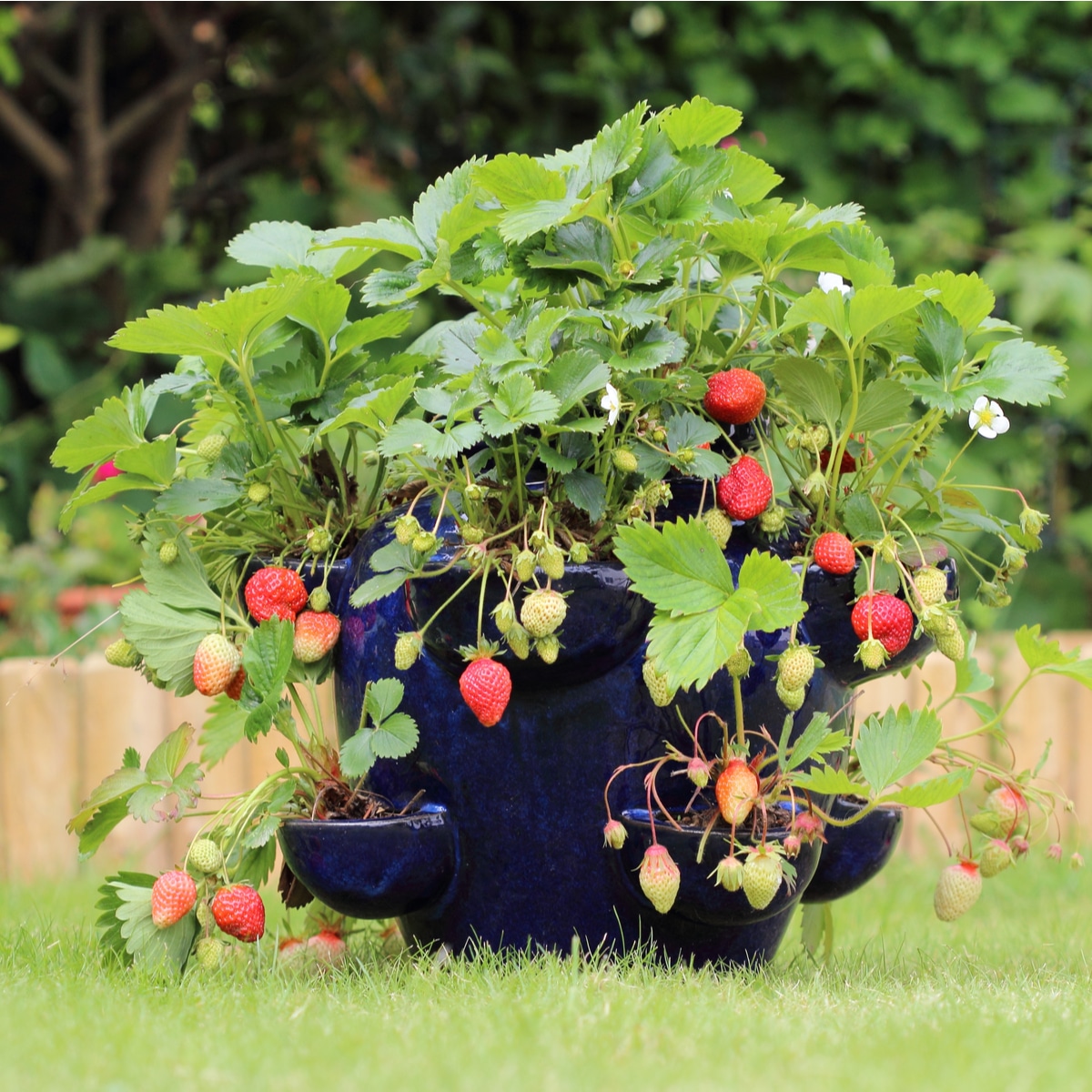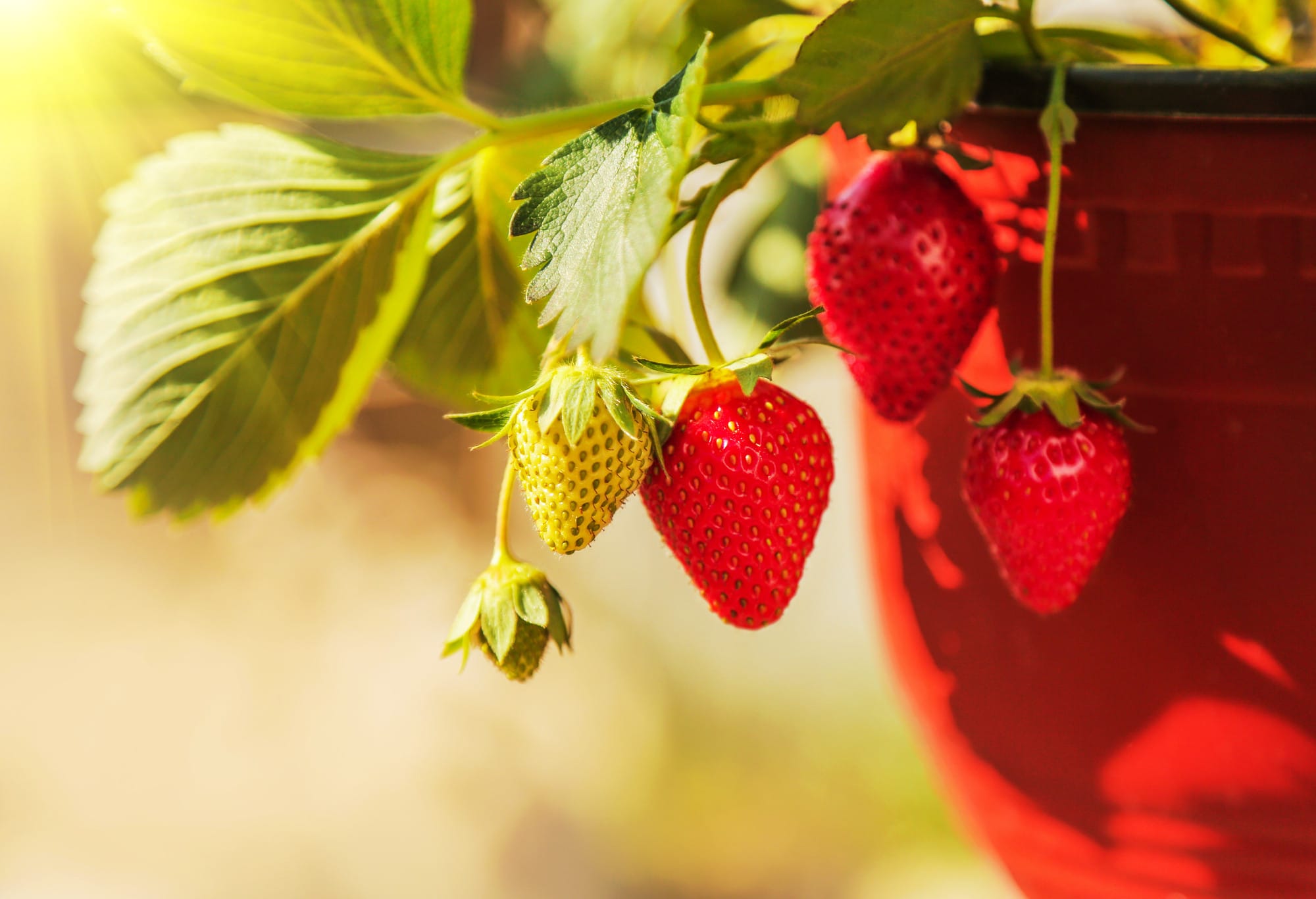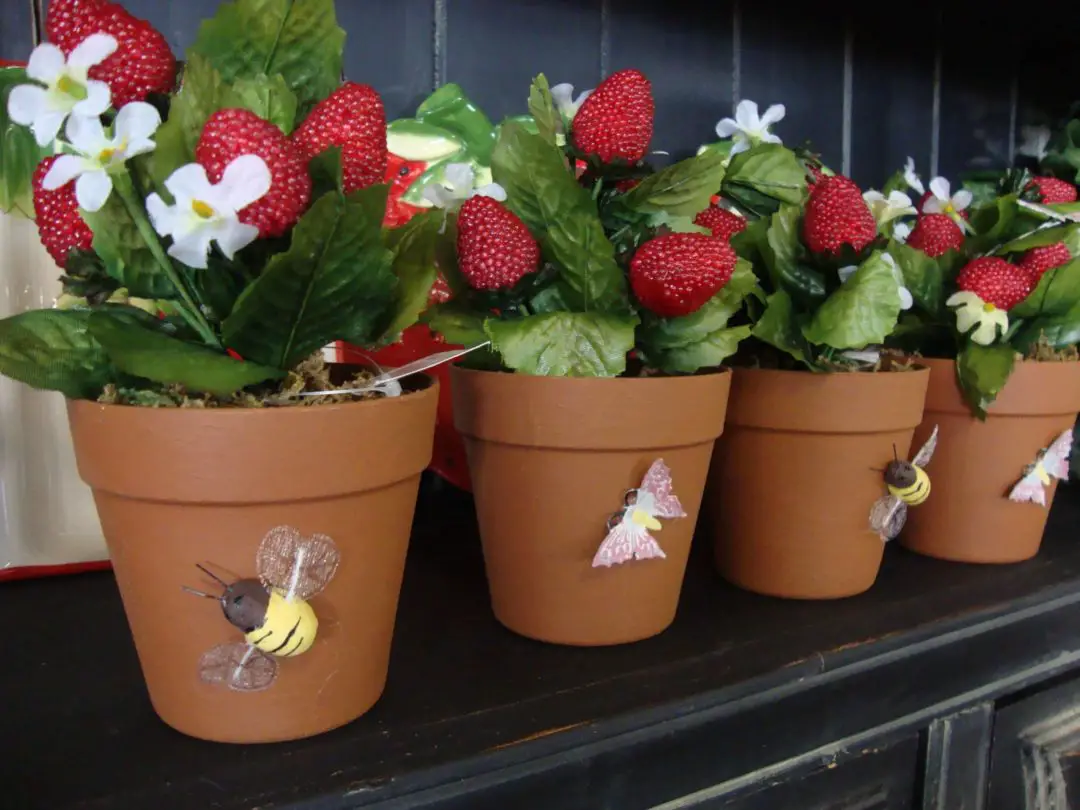Why Strawberries Thrive in Containers
Strawberries are one of the most popular fruits to grow in containers, and for good reason. Container gardening offers several advantages that make it an ideal way to cultivate these delicious berries. For one, containers provide better soil quality control, allowing gardeners to tailor the soil mix to the specific needs of their strawberry plants. This is particularly important for strawberries, which require a slightly acidic to neutral soil pH (between 5.5 and 6.5) to thrive.
In addition to improved soil quality, containers also offer improved drainage, which is essential for strawberry plants. Strawberries don’t like wet feet, and excess moisture can lead to root rot and other problems. By using a well-draining potting mix and a container with good drainage holes, gardeners can ensure that their strawberry plants receive the right amount of moisture without becoming waterlogged.
Another benefit of growing strawberries in containers is increased accessibility. Containers can be placed on balconies, patios, or even indoors, making it possible for anyone to grow strawberries, regardless of the amount of space they have available. This is especially useful for urban gardeners or those with limited mobility, who may not have access to a traditional garden bed.
Finally, container gardening makes it easy to move strawberry plants around to optimize their growing conditions. Strawberries require full sun to produce well, so containers can be moved to a sunny location during the day and then brought back to a shadier spot in the evening to protect the plants from extreme temperatures.
By taking advantage of these benefits, gardeners can successfully grow strawberries in containers and enjoy a bountiful harvest of delicious, juicy berries. Whether you’re a seasoned gardener or just starting out, planting strawberries in a pot is a great way to get started with container gardening.
Choosing the Right Strawberry Variety for Container Gardening
When it comes to planting strawberries in a pot, selecting the right variety is crucial for success. There are several types of strawberry varieties to choose from, each with its own unique characteristics and growing requirements. Understanding the differences between these varieties will help you choose the best one for your container gardening needs.
June-bearing strawberries are one of the most common varieties and produce large, flavorful berries in the spring. They are ideal for container gardening because they are compact, produce few runners, and are relatively low maintenance. However, they do require a period of cold winter weather to induce flowering, which can be a challenge in warmer climates.
Ever-bearing strawberries, on the other hand, produce smaller berries throughout the growing season, rather than in a single large crop. They are well-suited for container gardening because they are compact, produce few runners, and are relatively low maintenance. They also do not require a period of cold winter weather to induce flowering, making them a good choice for warmer climates.
Day-neutral strawberries are a type of ever-bearing strawberry that produces berries continuously throughout the growing season, regardless of the length of daylight. They are ideal for container gardening because they are compact, produce few runners, and are relatively low maintenance. They also do not require a period of cold winter weather to induce flowering, making them a good choice for warmer climates.
Other factors to consider when choosing a strawberry variety for container gardening include disease resistance, flavor, and texture. Some popular varieties for container gardening include ‘Albion’, ‘Camarosa’, and ‘Seascape’. These varieties are known for their compact growth habit, high yields, and excellent flavor.
Ultimately, the best strawberry variety for container gardening will depend on your specific needs and preferences. By considering factors such as climate, space, and desired yield, you can choose a variety that will thrive in your container garden and provide you with a bountiful harvest of delicious strawberries.
How to Select the Perfect Pot for Your Strawberry Plants
When it comes to planting strawberries in a pot, selecting the right container is crucial for optimal growth and fruit production. The pot should provide good drainage, aeration, and sunlight exposure, while also being large enough to accommodate the mature size of the strawberry plant.
Size is an important consideration when choosing a pot for strawberry plants. A pot that is too small can lead to waterlogged soil and root bound plants, while a pot that is too large can be cumbersome and difficult to move. A good rule of thumb is to choose a pot that is at least 6-8 inches deep and 8-12 inches wide. This will provide enough room for the strawberry plant to grow and produce fruit, while also being compact enough to fit on a balcony or patio.
Material is also an important consideration when choosing a pot for strawberry plants. Terracotta pots are a popular choice because they are breathable, allowing for good air circulation and moisture release. However, they can be heavy and may require additional support. Plastic pots are another option, but they can retain too much heat and moisture, which can be detrimental to strawberry plants. A good alternative is to use a pot made from a breathable material, such as wood or bamboo.
Drainage is also critical when choosing a pot for strawberry plants. Strawberry plants don’t like wet feet, so it’s essential to choose a pot with good drainage holes to prevent waterlogged soil. Look for pots with built-in drainage holes or consider adding a layer of small rocks or broken pottery to the bottom of the pot to improve drainage.
Aeration is also important for strawberry plants. They require good air circulation to prevent fungal diseases and promote healthy growth. Look for pots with built-in aeration holes or consider adding a layer of small rocks or broken pottery to the bottom of the pot to improve aeration.
Sunlight exposure is also critical for strawberry plants. They require full sun to produce well, so choose a pot that can be placed in a sunny location. Consider using a pot with a built-in trellis or other support system to keep the strawberry plant upright and exposed to sunlight.
By considering these factors, you can choose the perfect pot for your strawberry plants and enjoy a bountiful harvest of delicious, juicy strawberries.
Preparing the Soil for Optimal Strawberry Growth
When it comes to planting strawberries in a pot, the quality of the soil is crucial for optimal growth and fruit production. Strawberry plants require a well-draining, nutrient-rich soil that is specifically designed for container gardening. In this section, we will discuss the importance of using high-quality potting soil and provide guidance on how to mix in organic matter, fertilizers, and other amendments to create a nutrient-rich soil blend.
High-quality potting soil is essential for strawberry plants because it provides the necessary nutrients and water-holding capacity for optimal growth. Look for a potting soil that is specifically designed for container gardening and contains a mix of peat moss, vermiculite, and perlite. These ingredients will help to retain moisture, suppress diseases, and improve soil structure.
In addition to using high-quality potting soil, it’s also important to mix in organic matter such as compost or well-rotted manure. These amendments will help to improve soil fertility, structure, and overall health. Compost can be added to the soil at a rate of 10-20% of the total soil volume, while well-rotted manure can be added at a rate of 5-10%.
Fertilizers are also an important consideration when preparing the soil for strawberry plants. A balanced fertilizer that contains equal amounts of nitrogen, phosphorus, and potassium (NPK) is ideal for strawberry plants. Look for a fertilizer that is specifically designed for container gardening and follow the instructions on the label for application rates.
Other amendments that can be added to the soil to improve its fertility and structure include bone meal, alfalfa meal, and kelp meal. These amendments are high in nutrients and can help to promote healthy plant growth. However, be sure to follow the instructions on the label for application rates to avoid over-fertilizing.
Once you have prepared the soil, it’s time to plant your strawberry plants. Make sure to plant them at the same depth as they were in the pot and water them well after planting. With proper care and maintenance, your strawberry plants should thrive in their new container home.
By following these tips and using high-quality potting soil, you can create a nutrient-rich soil blend that will promote healthy growth and fruit production in your strawberry plants. Whether you’re a seasoned gardener or just starting out, planting strawberries in a pot is a great way to enjoy fresh, delicious strawberries right in your own backyard.
A Step-by-Step Guide to Planting Strawberries in a Pot
Planting strawberries in a pot is a straightforward process that requires some basic gardening tools and a little bit of know-how. Here’s a step-by-step guide to help you get started:
Step 1: Choose a Healthy Strawberry Plant
When selecting a strawberry plant, look for one that is healthy and disease-free. Choose a plant with bright green leaves and a robust root system. Avoid plants with yellow or wilted leaves, as they may be stressed or diseased.
Step 2: Prepare the Pot
Before planting, make sure the pot is clean and free of debris. If using a new pot, rinse it with water to remove any dust or residue. If using a pot that has been previously used, sterilize it with a solution of 1 part bleach to 10 parts water.
Step 3: Add Potting Soil
Fill the pot with a high-quality potting soil that is specifically designed for container gardening. Leave about 1-2 inches of space at the top of the pot for watering.
Step 4: Plant the Strawberry
Gently remove the strawberry plant from its container and place it in the pot. Make sure the crown of the plant (where the roots and leaves meet) is level with the soil surface. Add more potting soil around the roots, gently firming it in place as you go.
Step 5: Water and Mulch
Water the strawberry plant thoroughly after planting. Add a layer of mulch around the base of the plant to retain moisture and suppress weeds. Keep the mulch layer thin (about 1-2 inches) to prevent it from washing away.
Step 6: Provide Support (Optional)
If you’re growing a variety of strawberry that produces long runners, you may need to provide support to keep the plant upright. Use a trellis or stake to keep the plant from toppling over.
By following these steps, you should be able to successfully plant strawberries in a pot. Remember to provide your strawberry plant with plenty of sunlight, water, and nutrients to ensure a bountiful harvest.
With proper care and maintenance, your strawberry plant should thrive in its new container home. Happy planting!
Tips for Ongoing Care and Maintenance
Once you’ve successfully planted strawberries in a pot, it’s essential to provide ongoing care and maintenance to ensure a bountiful harvest. Here are some tips to help you keep your strawberry plants happy and healthy:
Watering: Strawberries need consistent moisture, especially when they’re producing fruit. Water your plants when the top inch of soil feels dry to the touch. Avoid overwatering, which can lead to root rot and other problems.
Fertilizing: Feed your strawberry plants with a balanced fertilizer (10-10-10) once a month. You can also use a fertilizer specifically formulated for strawberries, which will provide the necessary nutrients for optimal growth and fruit production.
Pruning: Prune your strawberry plants regularly to encourage bushy growth and prevent them from becoming leggy. Remove any dead or damaged leaves or stems, and trim back the plant to about 6 inches from the ground after it finishes producing fruit.
Pest Management: Keep an eye out for pests like aphids, slugs, and snails, which can damage your strawberry plants. Use organic pest control methods whenever possible, such as neem oil or insecticidal soap.
Monitoring for Diseases: Regularly inspect your strawberry plants for signs of disease like yellowing leaves, black spots, or powdery mildew. Use fungicides or other treatments as needed to prevent the spread of disease.
Repotting: Strawberries typically need to be repotted every 6-12 months, as their roots can become pot-bound. Choose a pot that is slightly larger than the previous one, and use fresh potting soil to give your plants a nutrient boost.
By following these tips, you’ll be able to keep your strawberry plants healthy and thriving, and enjoy a bountiful harvest of delicious, juicy strawberries.
Remember, planting strawberries in a pot is a fun and rewarding experience, and with proper care and maintenance, you’ll be enjoying fresh strawberries in no time.
Common Challenges and Solutions for Growing Strawberries in Pots
While growing strawberries in pots can be a rewarding experience, there are some common challenges that may arise. Here are some of the most common issues and their solutions:
Pests: Aphids, slugs, and snails are common pests that can damage strawberry plants. To control these pests, use organic pest control methods such as neem oil or insecticidal soap. You can also introduce beneficial insects like ladybugs or lacewings to your garden.
Diseases: Fungal diseases like powdery mildew and botrytis can infect strawberry plants. To prevent these diseases, ensure good air circulation around your plants, and avoid overhead watering. You can also use fungicides or other treatments as needed.
Nutrient Deficiencies: Strawberry plants require a balanced diet of nutrients to produce well. If your plants are not receiving enough nutrients, they may become deficient in certain micronutrients. To address this, use a balanced fertilizer that contains micronutrients like iron, zinc, and boron.
Waterlogged Soil: Strawberry plants don’t like wet feet, so it’s essential to ensure that the soil drains well. If the soil is waterlogged, it can lead to root rot and other problems. To prevent this, use a well-draining potting mix, and avoid overwatering.
Temperature Extremes: Strawberry plants prefer temperatures between 60°F and 70°F (15°C and 21°C). If the temperature is too high or too low, it can affect plant growth and fruit production. To address this, move your plants to a location with a more stable temperature.
By being aware of these common challenges and taking steps to prevent them, you can enjoy a successful and rewarding experience growing strawberries in pots.
Remember, planting strawberries in a pot is a fun and rewarding experience, and with the right care and attention, you can enjoy a bountiful harvest of delicious, juicy strawberries.
Enjoying Your Homegrown Strawberries: Harvesting and Using Your Crop
There’s nothing quite like the joy of harvesting homegrown strawberries from your very own container garden. The sweet taste and aroma of freshly picked strawberries are a true delight, and with a little creativity, you can enjoy them in a variety of delicious ways.
Harvesting Your Strawberries
Strawberries are typically ready to harvest about 60 days after planting. Check your plants regularly for ripe berries, which will be bright red and slightly soft to the touch. Gently grasp the berry and twist it to release it from the plant.
Using Your Fresh Strawberries
There are countless ways to enjoy your fresh strawberries, from simple snacks to elaborate desserts. Here are a few ideas to get you started:
Snacking: Enjoy your fresh strawberries as a healthy snack on their own, or paired with a dollop of whipped cream or a sprinkle of sugar.
Salads: Slice your strawberries and add them to green salads, fruit salads, or grain salads for a burst of sweetness and flavor.
Smoothies: Blend your strawberries with yogurt, milk, and honey for a quick and refreshing smoothie.
Baked Goods: Use your fresh strawberries in muffins, cakes, and tarts for a sweet and flavorful treat.
Preserving: Consider preserving your strawberries through freezing, jam-making, or dehydrating to enjoy them year-round.
With a little creativity and experimentation, the possibilities for using your homegrown strawberries are endless. So go ahead, get harvesting, and enjoy the fruits of your labor!
By following these tips and ideas, you’ll be able to enjoy your homegrown strawberries in a variety of delicious ways, and make the most of your container gardening experience.







/Strawberryplant-GettyImages-123533002-5b198b33eb97de0036be58ae-d5982c5730984563a32598ee2a96fe3e.jpg)
:max_bytes(150000):strip_icc()/growing-strawberries-in-pots-848167-03-96cef10e8f8a4067af5e4fc14b3418d4.jpg)